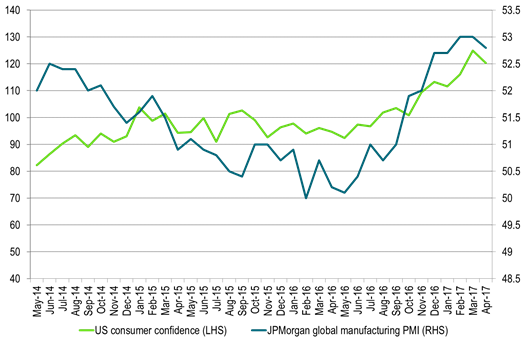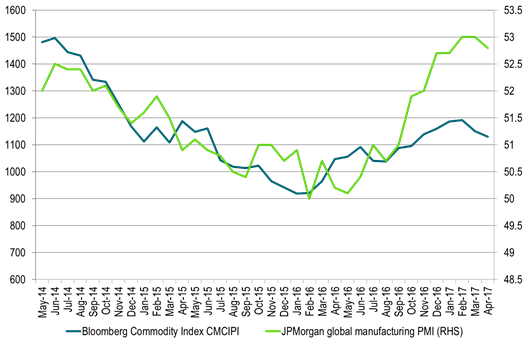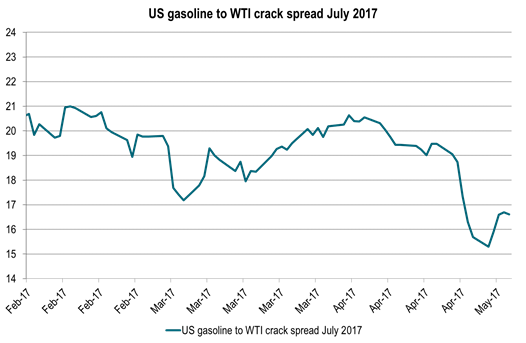Analys
Crude oil comment – The dissconnect and the reconnect

 Brent crude sold off 4.7% ydy to a close of $48.38/b (1 mth contract) while in the longer dated contracts we saw the December 2020 contract lose 2.1% to trade down to $51.15/b which was the lowest level since April 2016. Early this morning the Dec 2020 contract traded as low as $50.5/b. At the time of writing the 1 mth Brent contract is up 0.5% to $48.6/b after having traded as low as $46.64/b in the early hours of the day.
Brent crude sold off 4.7% ydy to a close of $48.38/b (1 mth contract) while in the longer dated contracts we saw the December 2020 contract lose 2.1% to trade down to $51.15/b which was the lowest level since April 2016. Early this morning the Dec 2020 contract traded as low as $50.5/b. At the time of writing the 1 mth Brent contract is up 0.5% to $48.6/b after having traded as low as $46.64/b in the early hours of the day.
The discussion is going left, right and centre for explanations of why we have such a sharp sell-off in commodities in general and oil specifically. Is the macro backdrop deteriorating? The decline in US consumer confidence by 5 points from March to April as well as a topping over of the global manufacturing PMI at the same time might have been a queue to macro driven investors to take profits on commodities in general. The general view is however that the macro backdrop is fine. That US Q1 growth weakness is transitory and that Chinese infrastructure contractor order intake was strong in Q1-17. Chinese tightening liquidity settings aiming to prevent overheating and too much speculative activity is probably a part of the reason for the sell-off in metals. As such it seems like there is a disconnect between the general macro-view which looks overall positive and the current commodity sell-off which is blood red. Graphing global PMI to commodities does however paint a picture of a fairly good relationship. Is the commodity sell-off an indicator that the somewhat rosy macro view is wrong? Probably not seems to be the main view so far.
Another angel for the sell-off in crude oil is US gasoline. Looking at the sell-off in crude oil we can see that the sell-off has been preceded by a sell-off in gasoline. Gasoline and the driving season is normally a bullish element this time of year. Counter to normal we have instead had a sell-off in gasoline which has been feeding into a bearish pressure on crude oil as well. So weakening US gasoline prices clearly are partly to blame for the latest crude sell-off.
Rapidly rising US crude oil production in combination with elevated net long speculative positions in WTI has of course been important foundation for the current sell-off. Speculators have been taking cover as the price moved into technically bearish territory. On Tuesday next week the US EIA will publish its last monthly energy report before OPEC’s meeting on May 25th. It is likely to lift its projected US crude oil production for 2018 yet another 150 – 200 kb/d as it accounts for the 35 oil rigs which were added to the market in April.
Hardly anyone seems to doubt that OPEC will roll over its cuts from H1 to H2 and Russia also seems to be positive for such a decision. This is probably the biggest disconnect in the oil sell-off. OPEC seems positive for cuts, Russia seems positive and the general market expectation is for a roll-over of cuts into H2. A decision to roll over cuts into H2-17 when OPEC meets on May 25th in Vienna will clearly lift Brent crude oil prices back up towards $55/b. As such the current sell-off to $46-47-48/b is clearly a disconnect to the consensus that OPEC will cut in H2-17. Cutting in H2-17 will however stimulate more US oil rigs to enter the market thus leading to higher production in 2018 and 2019. As such a decision to cut on May 25th will be a sacrifice of the balance and oil prices for 2018 and 2019 as it will shift both of those years into strict surplus.
But for now the sell-off is a disconnect to the view that OPEC will cut. As such it is a good buy ahead of the OPEC meeting which is now less than three weeks ahead. Unless of course OPEC totally caves in and instead lets oil production flow unhindered. That would be a vindication of prior Saudi oil minister Ali al-Naimi’s earlier aired view that cutting production is not a good idea as it would only lead to lower volume but not necessarily a higher price. Saudi Arabia may however have too much at stake with its planned Saudi Aramco IPO planned for early 2018 to let the oil flow loose quite yet. Thus betting on the consensus for a cut and buying the current sell-off may not be such a bad idea and strattegy. Rather we think it is a good strattegy to buy into the current sell-off at the moment ahead of the upcoming OPEC meeting.
On the one hand there is now a dissconnect between a strong belief in an OPEC cut versus a current weak oil prices. On the other hand though one might also say that the oil price finally has reconnected with shale oil fundamentals. If the oil market is in no need for yet more oil in 2018 then there is no need to activate yet more oil rigs in the US right now. At the moment we forecast 2018 to be close to balanced. As such the mid-term WTI crude price curve should traded at about $47/b (empirical rig count inflection point versus prices). The 1-2 year WTI forward curve at the time of writing trades at $47.8/b. But that reconnect looks likely to be foreced apart again if/when OPEC decides to roll cuts over into H2-17. In that case the reconnect is postponed to 2018. Post the Saudi Aramco IPO.
Ch1: Global growth momentum topping out?
Graphically yes, but general view is that global growth is fine and that US Q1-17 weakness is transitory
Ch2: Commodity prices are softening anyhow
Ch3: Gasoline prices usually a bullish factor into the US driving seasson – But this time it has been a bearish factor dragging crude prices lower
Ch4: Relationship between US mid-term WTI forward prices and weekly US oil rig additions
The inflection point is from April/May/June last year
Kind regards
Bjarne Schieldrop
Chief analyst, Commodities
SEB Markets
Merchant Banking
Analys
Tightening fundamentals – bullish inventories from DOE

The latest weekly report from the US DOE showed a substantial drawdown across key petroleum categories, adding more upside potential to the fundamental picture.

Commercial crude inventories (excl. SPR) fell by 5.8 million barrels, bringing total inventories down to 415.1 million barrels. Now sitting 11% below the five-year seasonal norm and placed in the lowest 2015-2022 range (see picture below).
Product inventories also tightened further last week. Gasoline inventories declined by 2.1 million barrels, with reductions seen in both finished gasoline and blending components. Current gasoline levels are about 3% below the five-year average for this time of year.
Among products, the most notable move came in diesel, where inventories dropped by almost 4.1 million barrels, deepening the deficit to around 20% below seasonal norms – continuing to underscore the persistent supply tightness in diesel markets.
The only area of inventory growth was in propane/propylene, which posted a significant 5.1-million-barrel build and now stands 9% above the five-year average.
Total commercial petroleum inventories (crude plus refined products) declined by 4.2 million barrels on the week, reinforcing the overall tightening of US crude and products.


Analys
Bombs to ”ceasefire” in hours – Brent below $70

A classic case of “buy the rumor, sell the news” played out in oil markets, as Brent crude has dropped sharply – down nearly USD 10 per barrel since yesterday evening – following Iran’s retaliatory strike on a U.S. air base in Qatar. The immediate reaction was: “That was it?” The strike followed a carefully calibrated, non-escalatory playbook, avoiding direct threats to energy infrastructure or disruption of shipping through the Strait of Hormuz – thus calming worst-case fears.

After Monday morning’s sharp spike to USD 81.4 per barrel, triggered by the U.S. bombing of Iranian nuclear facilities, oil prices drifted sideways in anticipation of a potential Iranian response. That response came with advance warning and caused limited physical damage. Early this morning, both the U.S. President and Iranian state media announced a ceasefire, effectively placing a lid on the immediate conflict risk – at least for now.
As a result, Brent crude has now fallen by a total of USD 12 from Monday’s peak, currently trading around USD 69 per barrel.
Looking beyond geopolitics, the market will now shift its focus to the upcoming OPEC+ meeting in early July. Saudi Arabia’s decision to increase output earlier this year – despite falling prices – has drawn renewed attention considering recent developments. Some suggest this was a response to U.S. pressure to offset potential Iranian supply losses.
However, consensus is that the move was driven more by internal OPEC+ dynamics. After years of curbing production to support prices, Riyadh had grown frustrated with quota-busting by several members (notably Kazakhstan). With Saudi Arabia cutting up to 2 million barrels per day – roughly 2% of global supply – returns were diminishing, and the risk of losing market share was rising. The production increase is widely seen as an effort to reassert leadership and restore discipline within the group.
That said, the FT recently stated that, the Saudis remain wary of past missteps. In 2018, Riyadh ramped up output at Trump’s request ahead of Iran sanctions, only to see prices collapse when the U.S. granted broad waivers – triggering oversupply. Officials have reportedly made it clear they don’t intend to repeat that mistake.
The recent visit by President Trump to Saudi Arabia, which included agreements on AI, defense, and nuclear cooperation, suggests a broader strategic alignment. This has fueled speculation about a quiet “pump-for-politics” deal behind recent production moves.
Looking ahead, oil prices have now retraced the entire rally sparked by the June 13 Israel–Iran escalation. This retreat provides more political and policy space for both the U.S. and Saudi Arabia. Specifically, it makes it easier for Riyadh to scale back its three recent production hikes of 411,000 barrels each, potentially returning to more moderate increases of 137,000 barrels for August and September.
In short: with no major loss of Iranian supply to the market, OPEC+ – led by Saudi Arabia – no longer needs to compensate for a disruption that hasn’t materialized, especially not to please the U.S. at the cost of its own market strategy. As the Saudis themselves have signaled, they are unlikely to repeat previous mistakes.
Conclusion: With Brent now in the high USD 60s, buying oil looks fundamentally justified. The geopolitical premium has deflated, but tensions between Israel and Iran remain unresolved – and the risk of missteps and renewed escalation still lingers. In fact, even this morning, reports have emerged of renewed missile fire despite the declared “truce.” The path forward may be calmer – but it is far from stable.
Analys
A muted price reaction. Market looks relaxed, but it is still on edge waiting for what Iran will do

Brent crossed the 80-line this morning but quickly fell back assigning limited probability for Iran choosing to close the Strait of Hormuz. Brent traded in a range of USD 70.56 – 79.04/b last week as the market fluctuated between ”Iran wants a deal” and ”US is about to attack Iran”. At the end of the week though, Donald Trump managed to convince markets (and probably also Iran) that he would make a decision within two weeks. I.e. no imminent attack. Previously when when he has talked about ”making a decision within two weeks” he has often ended up doing nothing in the end. The oil market relaxed as a result and the week ended at USD 77.01/b which is just USD 6/b above the year to date average of USD 71/b.

Brent jumped to USD 81.4/b this morning, the highest since mid-January, but then quickly fell back to a current price of USD 78.2/b which is only up 1.5% versus the close on Friday. As such the market is pricing a fairly low probability that Iran will actually close the Strait of Hormuz. Probably because it will hurt Iranian oil exports as well as the global oil market.
It was however all smoke and mirrors. Deception. The US attacked Iran on Saturday. The attack involved 125 warplanes, submarines and surface warships and 14 bunker buster bombs were dropped on Iranian nuclear sites including Fordow, Natanz and Isfahan. In response the Iranian Parliament voted in support of closing the Strait of Hormuz where some 17 mb of crude and products is transported to the global market every day plus significant volumes of LNG. This is however merely an advise to the Supreme leader Ayatollah Ali Khamenei and the Supreme National Security Council which sits with the final and actual decision.
No supply of oil is lost yet. It is about the risk of Iran closing the Strait of Hormuz or not. So far not a single drop of oil supply has been lost to the global market. The price at the moment is all about the assessed risk of loss of supply. Will Iran choose to choke of the Strait of Hormuz or not? That is the big question. It would be painful for US consumers, for Donald Trump’s voter base, for the global economy but also for Iran and its population which relies on oil exports and income from selling oil out of that Strait as well. As such it is not a no-brainer choice for Iran to close the Strait for oil exports. And looking at the il price this morning it is clear that the oil market doesn’t assign a very high probability of it happening. It is however probably well within the capability of Iran to close the Strait off with rockets, mines, air-drones and possibly sea-drones. Just look at how Ukraine has been able to control and damage the Russian Black Sea fleet.
What to do about the highly enriched uranium which has gone missing? While the US and Israel can celebrate their destruction of Iranian nuclear facilities they are also scratching their heads over what to do with the lost Iranian nuclear material. Iran had 408 kg of highly enriched uranium (IAEA). Almost weapons grade. Enough for some 10 nuclear warheads. It seems to have been transported out of Fordow before the attack this weekend.
The market is still on edge. USD 80-something/b seems sensible while we wait. The oil market reaction to this weekend’s events is very muted so far. The market is still on edge awaiting what Iran will do. Because Iran will do something. But what and when? An oil price of 80-something seems like a sensible level until something do happen.
-

 Nyheter4 veckor sedan
Nyheter4 veckor sedanStor uppsida i Lappland Guldprospekterings aktie enligt analys
-

 Nyheter4 veckor sedan
Nyheter4 veckor sedanSilverpriset släpar efter guldets utveckling, har mer uppsida
-

 Nyheter3 veckor sedan
Nyheter3 veckor sedanUppgången i oljepriset planade ut under helgen
-

 Nyheter3 veckor sedan
Nyheter3 veckor sedanLåga elpriser i sommar – men mellersta Sverige får en ökning
-

 Nyheter2 veckor sedan
Nyheter2 veckor sedanMahvie Minerals växlar spår – satsar fullt ut på guld
-

 Analys3 veckor sedan
Analys3 veckor sedanVery relaxed at USD 75/b. Risk barometer will likely fluctuate to higher levels with Brent into the 80ies or higher coming 2-3 weeks
-

 Nyheter1 vecka sedan
Nyheter1 vecka sedanOljan, guldet och marknadens oroande tystnad
-

 Nyheter1 vecka sedan
Nyheter1 vecka sedanJonas Lindvall är tillbaka med ett nytt oljebolag, Perthro, som ska börsnoteras












